ThisiscontentfromElsevier'sDrugInformation
Darbepoetin Alfa
Learn more about Elsevier's Drug Information today! Get the drug data and decision support you need, including TRUE Daily Updates™ including every day including weekends and holidays.
General Dosing Information
0.45 mcg/kg/dose subcutaneously or IV every 4 weeks, initially. Monitor hemoglobin (Hgb) weekly until stable and then at least monthly (after initiation of therapy and each dose adjustment) and adjust dose based on Hgb. Do not increase the dose more frequently than every 4 weeks; decreases in dose can occur more frequently. Decrease or interrupt the dose if Hgb exceeds 10 g/dL. Use the lowest dose possible that will maintain a Hgb concentration sufficient to reduce the need for red blood cell transfusion. If response is not seen over a 12-week escalation period, increasing the dose further is unlikely to improve response and may increase risks; evaluate other causes of anemia and discontinue use if responsiveness does not improve.[31724]
0.45 mcg/kg/dose subcutaneously or IV once weekly or 0.75 mcg/kg/dose subcutaneously or IV every 2 weeks, initially. Monitor hemoglobin (Hgb) weekly until stable and then at least monthly (after initiation of therapy and each dose adjustment) and adjust dose based on Hgb. Do not increase the dose more frequently than every 4 weeks; decreases in dose can occur more frequently. Decrease or interrupt the dose if Hgb exceeds 12 g/dL. Use the lowest dose possible that will maintain a Hgb concentration sufficient to reduce the need for red blood cell transfusion. If response is not seen over a 12-week escalation period, increasing the dose further is unlikely to improve response and may increase risks; evaluate other causes of anemia and discontinue use if responsiveness does not improve.[31724]
0.45 mcg/kg/dose subcutaneously or IV once weekly or 0.75 mcg/kg/dose IV or subcutaneously every 2 weeks, initially. The IV route is recommended for individuals on hemodialysis. Monitor hemoglobin (Hgb) weekly until stable and then at least monthly (after initiation of therapy and each dose adjustment) and adjust dose based on Hgb. Do not increase the dose more frequently than every 4 weeks; decreases in dose can occur more frequently. Decrease or interrupt the dose if Hgb approaches or exceeds 11 g/dL. Use the lowest dose possible that will maintain a Hgb concentration sufficient to reduce the need for red blood cell transfusion. If response is not seen over a 12-week escalation period, increasing the dose further is unlikely to improve response and may increase risks; evaluate other causes of anemia and discontinue use if responsiveness does not improve.[31724]
0.45 mcg/kg/dose subcutaneously or IV once weekly, initially. The IV route is recommended for individuals on hemodialysis. Monitor hemoglobin (Hgb) weekly until stable and then at least monthly (after initiation of therapy and each dose adjustment) and adjust dose based on Hgb. Do not increase the dose more frequently than every 4 weeks; decreases in dose can occur more frequently. Decrease or interrupt the dose if Hgb exceeds 12 g/dL. Use the lowest dose possible that will maintain a Hgb concentration sufficient to reduce the need for red blood cell transfusion. If response is not seen over a 12-week escalation period, increasing the dose further is unlikely to improve response and may increase risks; evaluate other causes of anemia and discontinue use if responsiveness does not improve.[31724]
6.25 mcg subcutaneously or IV once weekly for 2,499 units/week or less of epoetin alfa; 12.5 mcg subcutaneously or IV once weekly for 2,500 to 4,999 units/week of epoetin alfa; 25 mcg subcutaneously or IV once weekly for 5,000 to 10,999 units/week of epoetin alfa; 40 mcg subcutaneously or IV once weekly for 11,000 to 17,999 units/week of epoetin alfa; 60 mcg subcutaneously or IV once weekly for 18,000 to 33,999 units/week of epoetin alfa; 100 mcg subcutaneously or IV once weekly for 34,000 to 89,999 units/week of epoetin alfa; and 200 mcg subcutaneously or IV once weekly for more than 90,000 units/week of epoetin alfa. The IV route is recommended for individuals on hemodialysis. Monitor hemoglobin (Hgb) weekly until stable and then at least monthly (after initiation of therapy and each dose adjustment) and adjust dose based on Hgb. Do not increase the dose more frequently than every 4 weeks; decreases in dose can occur more frequently. Decrease or interrupt the dose if Hgb exceeds 10 g/dL for dialysis-independent adults or approaches or exceeds 11 g/dL for dialysis-dependent adults. Use the lowest dose possible that will maintain a Hgb concentration sufficient to reduce the need for red blood cell transfusion. If response is not seen over a 12-week escalation period, increasing the dose further is unlikely to improve response and may increase risks; evaluate other causes of anemia and discontinue use if responsiveness does not improve.[31724]
6.25 mcg subcutaneously or IV once weekly for 1,500 to 2,499 units/week of epoetin alfa; 10 mcg subcutaneously or IV once weekly for 2,500 to 4,999 units/week of epoetin alfa; 20 mcg subcutaneously or IV once weekly for 5,000 to 10,999 units/week of epoetin alfa; 40 mcg subcutaneously or IV once weekly for 11,000 to 17,999 units/week of epoetin alfa; 60 mcg subcutaneously or IV once weekly for 18,000 to 33,999 units/week of epoetin alfa; 100 mcg subcutaneously or IV once weekly for 34,000 to 89,999 units/week of epoetin alfa; and 200 mcg subcutaneously or IV once weekly for more than 90,000 units/week of epoetin alfa. The IV route is recommended for individuals on hemodialysis. Monitor hemoglobin (Hgb) weekly until stable and then at least monthly (after initiation of therapy and each dose adjustment) and adjust dose based on Hgb. Do not increase the dose more frequently than every 4 weeks; decreases in dose can occur more frequently. Decrease or interrupt the dose if Hgb exceeds 12 g/dL. Use the lowest dose possible that will maintain a Hgb concentration sufficient to reduce the need for red blood cell transfusion. If response is not seen over a 12-week escalation period, increasing the dose further is unlikely to improve response and may increase risks; evaluate other causes of anemia and discontinue use if responsiveness does not improve.[31724]
2.25 mcg/kg/dose subcutaneously once weekly or 500 mcg subcutaneously every 3 weeks, initially. Monitor hemoglobin (Hgb) weekly until stable (after initiation of therapy and each dose adjustment) and adjust dose based on Hgb. Use the lowest dose possible that will maintain a Hgb concentration sufficient to reduce the need for red blood cell (RBC) transfusion. If response is not seen as measured by Hgb concentrations or RBC transfusions are still required after 8 weeks of therapy, discontinue use. Discontinue use when the chemotherapy course is completed.[31724]
10 mcg/kg/dose subcutaneously once weekly. In a study of 102 premature neonates, 33 of whom received darbepoetin alfa (gestational age 27.9 +/- 1.8 weeks), first doses were given at 46 +/- 27 hours of age and dosing continued until 35 completed weeks gestation or discharge. All neonates also received supplemental iron, folate, and vitamin E and were transfused according to a standardized, restrictive transfusion protocol. Treatment groups (darbepoetin alfa or erythropoietin) received fewer transfusions compared to placebo, and there was no significant difference between treatment groups.[63292] In supplementary studies, additional short- and long-term benefits such as reduced rates of necrotizing enterocolitis, intraventricular hemorrhage, and periventricular leukomalacia and improved neurodevelopmental outcomes have been reported with early erythropoiesis-stimulating treatments.[63293] [63294]
Dosage Adjustment Based on Hemoglobin
Chronic Kidney Disease
Myelosuppressive Cancer Chemotherapy
Varies depending on indication, frequency of administration, and individual response.
Varies depending on indication, frequency of administration, and individual response.
Varies depending on indication, frequency of administration, and individual response.
Varies depending on indication, frequency of administration, and individual response.
Varies depending on indication, frequency of administration, and individual response.
Neonates: Safety and efficacy have not been established.
Premature Neonates: Safety and efficacy have not been established; however, 10 mcg/kg/dose subcutaneously once weekly has been used off-label for anemia of prematurity.
Specific guidelines for dosage adjustments in hepatic impairment are not available; it appears that no dosage adjustments are needed.
Specific guidelines for dosage adjustments in renal impairment are not available; it appears that no dosage adjustments are needed.
† Off-label indication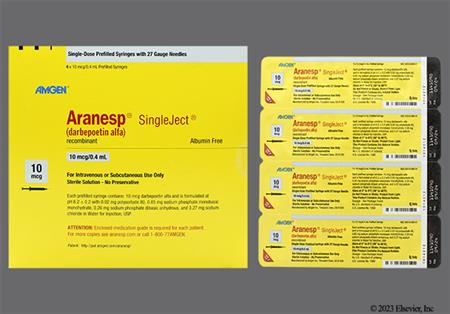
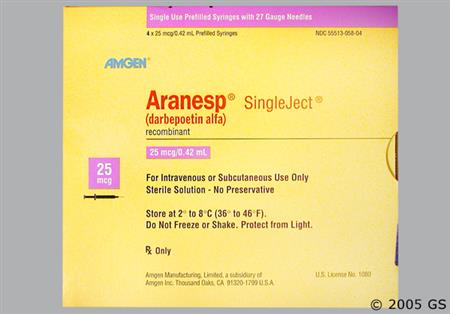
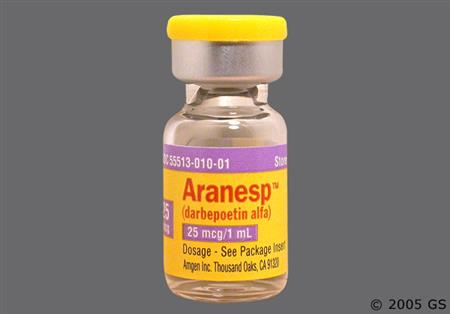
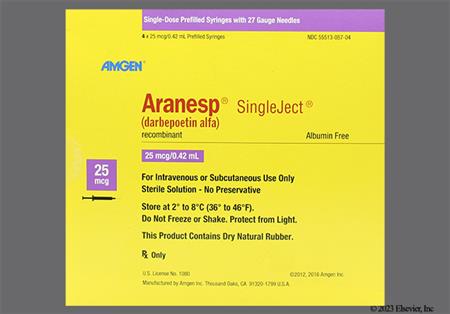

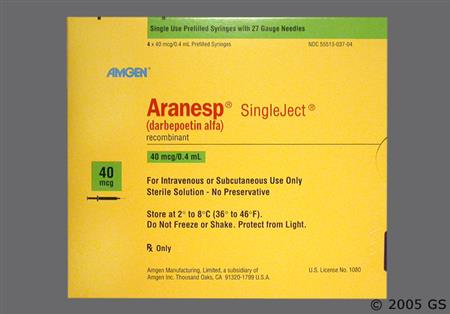
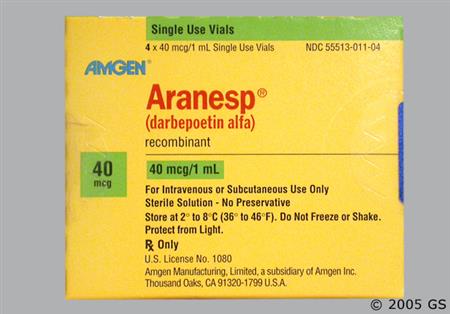
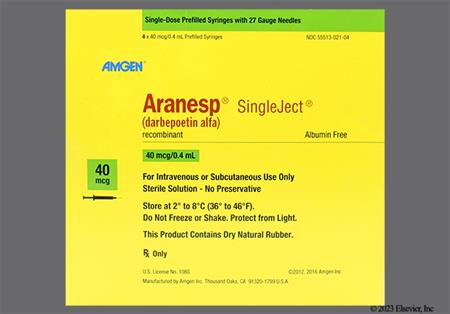
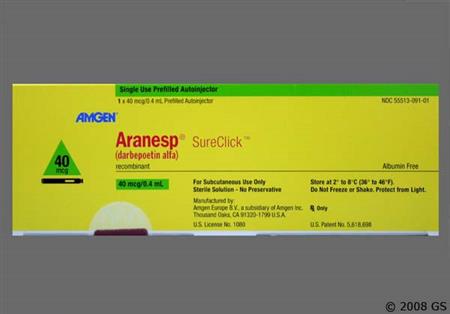
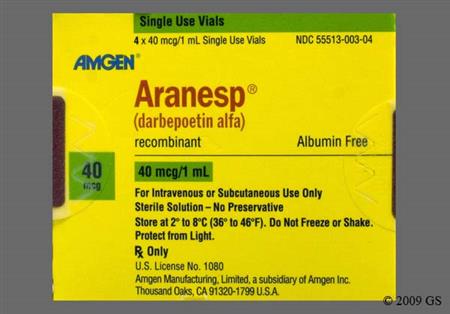
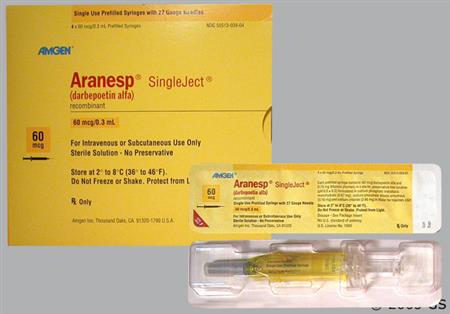

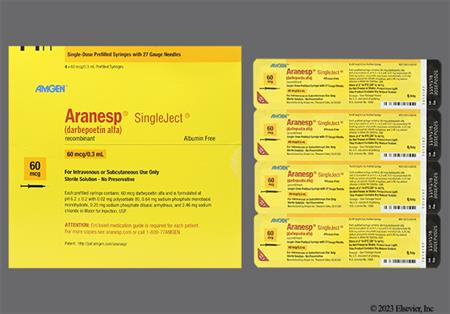
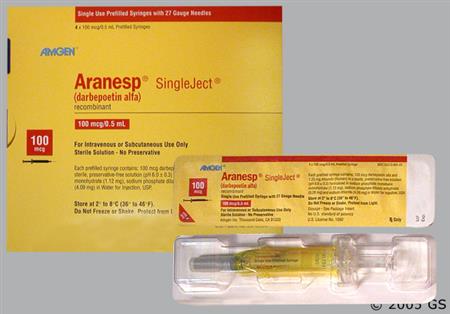
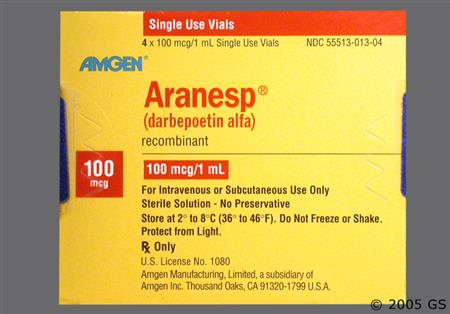
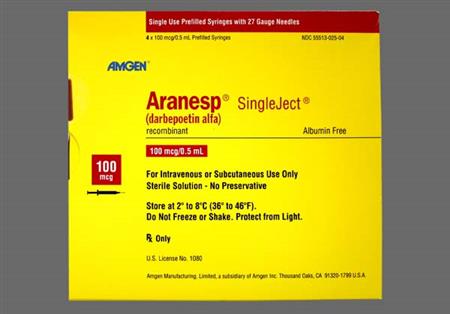
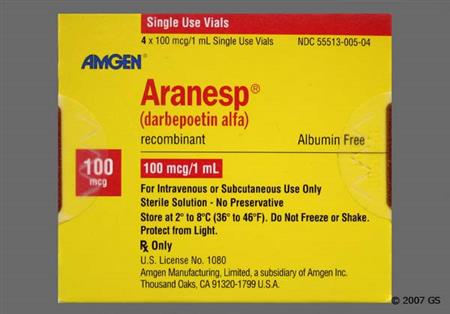
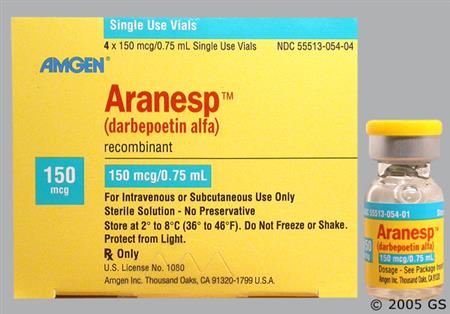
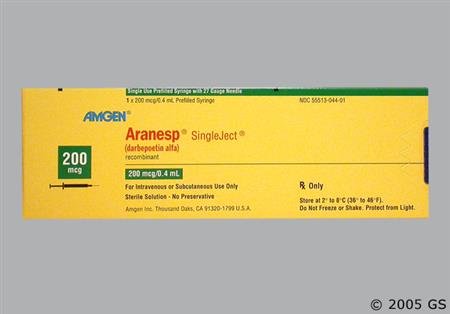
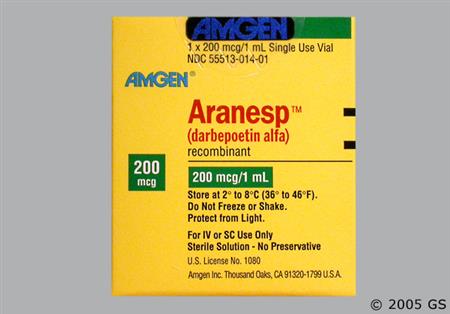

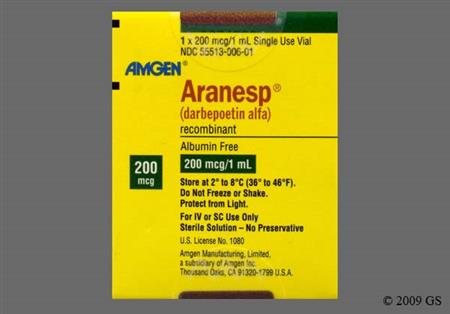
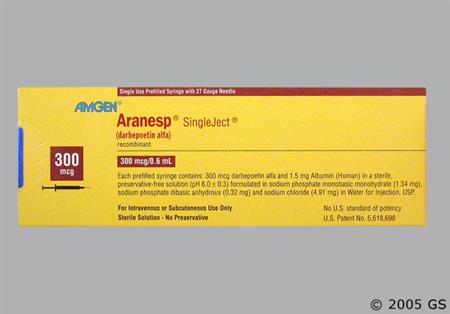
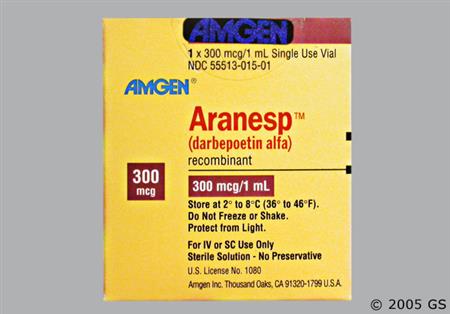
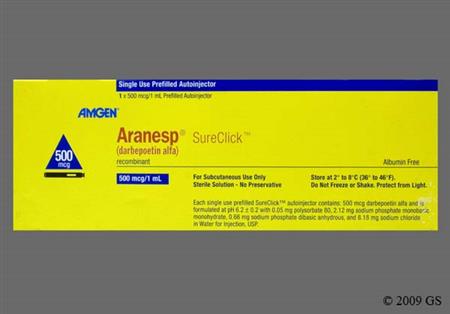
Darbepoetin alfa is an erythropoiesis-stimulating agent (ESA). It is indicated for the treatment of anemia due to chronic kidney disease (CKD) in patients aged 1 month or older or due to the myelosuppressive effects of chemotherapy in adult patients. Darbepoetin alfa is not indicated as a substitute for red blood cell transfusions in patients who require immediate correction of anemia. It is also not indicated in patients with cancer who are receiving hormonal agents, biologic products, or radiotherapy (unless they are also receiving concomitant myelosuppressive chemotherapy); myelosuppressive chemotherapy when the anticipated outcome is cure; or myelosuppressive chemotherapy in whom the anemia could be managed by transfusion. ESAs may increase the risk of death, serious adverse cardiovascular reactions, and stroke in CKD patients who achieve a hemoglobin concentration more than 11 g/dL. ESAs may shorten the overall survival time and increase the risk of tumor progression or recurrence in patients with cancer. Therefore, use the lowest darbepoetin alfa dose needed to reduce the need for red blood cell transfusions.[31724]
For storage information, see the specific product information within the How Supplied section.
Erythropoiesis-stimulating agents (ESAs) may increase the risk of death, cardiovascular adverse events including thromboembolism, and tumor progression or recurrence (in cancer patients). In pooled data from 5 randomized studies, angina (8%), vascular access complications (8%), and arteriovenous graft thrombosis (5%) were reported in 766 adult chronic kidney disease (CKD) patients who received darbepoetin alfa. Additionally, the risk of stroke was increased almost 2-fold (2.1% vs. 1.1%) in patients with CKD who received darbepoetin alfa compared with placebo in a randomized trial in 4,038 CKD patients not on dialysis. Among patients with CKD, those who received an ESA to target a hemoglobin concentration of 13 to 14 g/dL had greater risks for death, myocardial infarction (MI), stroke, congestive heart failure, thrombosis of hemodialysis vascular access, and other thromboembolic events as compared with the patients who had a hemoglobin target of 9 to 11.3 g/dL. In pooled data from 7 randomized, placebo-controlled studies, thromboembolic adverse events (5.1%) including arterial events (1.1%) such as MI (0.6%) and venous events (4.1%) such as pulmonary embolism (1.5%) occurred in 2,888 adult cancer patients who received darbepoetin alfa during chemotherapy. Cerebrovascular disorders including central nervous system/intracranial bleeding and cerebrovascular accident/stroke were reported in 1.3% of darbepoetin alfa-treated cancer patients. Due to the effects on erythropoiesis, abuse of darbepoetin alfa may be seen in athletes. Misuse of medications that increase erythropoiesis, such as darbepoetin alfa, by healthy persons may lead to life-threatening cardiovascular complications (e.g., stroke, myocardial infarction, and thromboembolism).[31724]
Darbepoetin increases the risk of seizures in patients with chronic kidney disease, and seizures have been observed during therapy. During the first several months after darbepoetin initiation, closely monitor patients for premonitory neurologic symptoms. Advise patients to contact their healthcare practitioner for new-onset seizures, premonitory symptoms, or change in seizure frequency. In a study of 81 pediatric patients with chronic renal failure, convulsions was reported as one of the most common adverse events (incidence unknown).[31724]
In patients receiving darbepoetin alfa for cancer, abdominal pain was reported in 13.2% of patients as compared with 9.4% of placebo recipients.[31724]
Serious allergic reactions, including anaphylactoid reactions, angioedema, bronchospasm, skin rash, and urticaria may occur with darbepoetin. Blistering and skin exfoliation reactions including erythema multiforme, Stevens-Johnson syndrome, and toxic epidermal necrolysis have been reported with darbepoetin in the postmarketing setting. If a serious reaction occurs, immediately and permanently discontinue darbepoetin alfa, and administer appropriate therapy. During clinical trials, skin rash (unspecified) and erythema were reported in 5% of patients with chronic kidney disease. An injection site reaction may occur. In a study of 81 pediatric chronic renal failure patients, injection site pain and rash were reported as common adverse events. Vascular access complications were noted in 8% of patients with chronic kidney disease.[31724]
During clinical trials, dyspnea was reported in 17% and cough in 12% of chronic renal failure patients who received darbepoetin alfa.[31724]
As with all therapeutic proteins, there is a potential for immunogenicity. The presence of neutralizing antibodies (i.e., anti-erythropoietin antibodies) has been associated with the development of pure red cell aplasia (PRCA) in patients receiving recombinant erythropoietin products.[27008][27009] [27010] PRCA cases have been reported predominantly in patients with chronic kidney disease receiving ESAs by subcutaneous administration. If severe anemia and low reticulocyte count develop during treatment, withhold darbepoetin and evaluate patients for neutralizing antibodies to erythropoietin. Further, evaluate any patient experiencing a lack or a loss of response to darbepoetin to determine the etiology of the lack or loss of effect. If typical causes of lack or loss of hemoglobin response are excluded, evaluate for PRCA. Permanently discontinue darbepoetin in patients who develop PRCA after treatment with any erythropoietin protein drug. Do not switch patients to other ESAs. Contact Amgen (800—77AMGEN) to perform assays for binding and neutralizing antibodies. Neutralizing antibodies to darbepoetin alfa that cross-react with endogenous erythropoietin and other ESAs can result in PRCA or severe anemia (with or without other cytopenias). In clinical studies, the percentage of patients with antibodies to darbepoetin was examined using the BIAcore assay. Sera from 1501 chronic kidney disease (CKD) patients and in 1159 cancer patients were tested. At baseline, prior to darbepoetin treatment, binding antibodies were detected in 59 (4%) of CKD patients and in 36 (3%) of cancer patients. While receiving darbepoetin therapy (range 22—177 weeks), a follow-up sample was taken. One additional CRF patient and eight additional cancer patients developed antibodies capable of binding darbepoetin. None of the patients had antibodies capable of neutralizing the activity of darbepoetin alfa or endogenous erythropoietin at baseline or at end of study. No clinical sequelae consistent with PRCA were associated with the presence of these antibodies. The incidence of antibody formation is highly dependent on the sensitivity and specificity of the assay. Comparison of the incidence of antibodies across products within this class (erythropoietic proteins) may be misleading.[31724]
Uncontrolled hypertension is a contraindication for darbepoetin receipt; appropriately control blood pressure before drug initiation and during its use. In clinical studies, approximately 40% of patients with chronic kidney disease required initiation or intensification of antihypertensive therapy during the early phase of treatment. Reduce or withhold darbepoetin if blood pressure becomes difficult to control. Advise patients of the importance of compliance with antihypertensive therapy and dietary restrictions. In chronic kidney disease patients, hypertension (31%), peripheral edema (17%), fluid overload (7%), hypertensive encephalopathy, and procedural hypotension (10%) have been reported during therapy with darbepoetin alfa. In a trial of 81 pediatric chronic kidney disease patients, hypertension was commonly reported (incidence unknown). Edema of any type was reported more frequently in darbepoetin-treated cancer patients (12.8%) than in patients who received placebo (9.7%).[31724]
Darbepoetin alfa increases hemoglobin synthesis decreasing erythrocyte pyridoxine status and may lead to vitamin B6 deficiency. Coadministration of low dose or moderate dose vitamin B6 may be beneficial. Supervise closely and monitor regularly, especially in patients with renal impairment.[63388]
Darbepoetin alfa is contraindicated in persons with pure red cell aplasia (PRCA) that begins after treatment with an erythropoietin protein drug. Cases of PRCA and severe anemia, with or without other cytopenias associated with neutralizing antibodies to erythropoietin, have been reported in persons treated with darbepoetin alfa, predominantly in persons with chronic kidney disease receiving an erythropoiesis-stimulating agent (ESA) by subcutaneous administration. If severe anemia and low reticulocyte count develop during treatment with darbepoetin alfa, withhold darbepoetin alfa and evaluate persons for neutralizing antibodies to erythropoietin. Contact the manufacturer (1-800-77-AMGEN) to perform assays for binding and neutralizing antibodies. Permanently discontinue darbepoetin alfa in persons who develop PRCA after treatment with darbepoetin alfa or other erythropoietin protein drugs. Do not switch patients to other erythropoietin-stimulating agents as antibodies may cross-react.[31724]
In controlled trials, patients with chronic kidney disease such as renal impairment or renal failure experienced greater risks for mortality, serious adverse cardiovascular reactions, and stroke when administered erythropoiesis-stimulating agents (ESAs) such as darbepoetin alfa to target a hemoglobin concentration greater than 11 g/dL. No trial has identified a hemoglobin target concentration, ESA dose, or dosing strategy that does not increase these risks. Use the lowest dose sufficient to reduce the need for red blood cell transfusions. For patients with chronic kidney disease either on or off dialysis, a hemoglobin less than 10 g/dL is advised before darbepoetin alfa initiation. In controlled clinical trials of patients with chronic kidney disease comparing higher hemoglobin targets (13 to 14 g/dL) to lower targets (9 to 11.3 g/dL), ESAs increased the risk of death, myocardial infarction, stroke, congestive heart failure, thrombosis of hemodialysis vascular access, and other thromboembolic events in the higher target groups. Using ESAs to target a hemoglobin concentration greater than 11 g/dL increases the risk of serious adverse cardiovascular reactions and has not been shown to provide additional benefit. Use caution in patients with coexistent cardiac disease, stroke, and cardiovascular disease such as angina. Patients with chronic kidney disease and an insufficient hemoglobin response to ESA therapy may be at even greater risk for cardiovascular reactions and mortality than other patients. A rate of hemoglobin rise of greater than 1 g/dL over 2 weeks may contribute to these risks; a dose reduction is warranted. During hemodialysis, patients treated with ESAs may require increased anticoagulant therapy with heparin to prevent clotting of the dialysis machine.[31724]
Use of erythropoiesis stimulating agents (ESAs) shortened overall survival and/or increased the risk of tumor progression or recurrence in clinical studies of patients with certain neoplastic disease: breast, non-small cell lung, head and neck, lymphoid, and cervical cancers. ESAs are not indicated for patients receiving myelosuppressive chemotherapy when the anticipated outcome is cure. Further, use ESAs only for anemia from myelosuppressive chemotherapy, and use the lowest dose to avoid red blood cell transfusions. Use of the lowest dose to avoid red blood cell transfusions will also help to decrease the risk of serious cardiovascular and thromboembolic reactions; in controlled clinical trials of patients with cancer, darbepoetin alfa and other ESAs increased the risks for death and serious adverse cardiovascular reactions such as myocardial infarction or stroke. Discontinue the ESA after the completion of a chemotherapy course.[31724]
Darbepoetin is contraindicated for use by patients with uncontrolled hypertension; control hypertension before and during darbepoetin therapy in all patients. Reduce or withhold darbepoetin if blood pressure becomes difficult to control. Advise patients about the importance of compliance with antihypertensive therapy and dietary restrictions. During the early phase of darbepoetin therapy in patients with chronic kidney disease, approximately 40% of patients require initiation of or intensification of antihypertensive therapy.[31724]
In patients with chronic kidney disease, darbepoetin increases the risk of seizures. During the first several months after darbepoetin initiation, closely monitor patients for premonitory neurologic symptoms. Advise patients to contact their healthcare provider for new-onset seizures or premonitory symptoms, or in patients with history of seizure disorder, a change in seizure frequency.[31724]
Darbepoetin alfa should be used with caution in patients with porphyria. Although there have been no reports of exacerbations of porphyria with darbepoetin alfa, exacerbations have been reported, rarely, with epoetin alfa.
Patients receiving darbepoetin alfa should be encouraged to maintain compliance with dietary and dialysis prescriptions, especially as treatment with darbepoetin alfa increases the patient's sense of well-being and quality of life. Although not reported during treatment with darbepoetin alfa, treatment with epoetin alfa has been associated with hyperkalemia, which most often occurred in association with poor compliance to medication, diet, and/or dialysis. Similar outcomes would be expected with darbepoetin alfa.
The majority of patients with chronic kidney disease will require iron supplementation during darbepoetin therapy. Evaluate iron status, including transferrin saturation and serum ferritin, in all patients before and during darbepoetin therapy and maintain iron repletion. Administer supplemental iron therapy when serum transferrin saturation is less than 20% or serum ferritin is less than 100 mcg/L. For lack or loss of hemoglobin response to darbepoetin, evaluate for causative factors, including iron-deficiency anemia.[31724]
Conditions that may interfere with response to darbepoetin alfa include bleeding, infection, inflammation, malignancy, malnutrition, hypothyroidism, hyperparathyroidism, vitamin B12 deficiency, folate deficiency, hematological disease (e.g., hemolytic anemia, sickle cell disease, thalassemia, refractory anemia), and bone marrow disorders, such as myelodysplastic syndrome (MDS). Evaluate for the cause of a lack of a hemoglobin response or failure to maintain a hemoglobin response with darbepoetin alfa. If possible, correct the etiology such as vitamin B12 or folate deficiency. In the absence of another etiology, evaluate for pure red cell aplasia (PRCA), including testing for the presence of antibodies to erythropoietin.[31724] [66652] In persons in whom all correctable causes have been maximally treated but who remain hyporesponsive, erythropoietin-stimulating agent therapy may be continued cautiously at doses up to 4 times the initial dose to prevent a further decline in hemoglobin concentration. Red blood cell transfusions can be used to prevent or treat anemia-related symptoms and signs.[66652]
The needle cover of the prefilled syringes contains dry natural rubber, which may cause allergic reactions in individuals with latex hypersensitivity. Rarely, potentially serious allergic reactions, including skin rash and urticaria, associated with darbepoetin alfa have been reported. Symptoms have recurred with rechallenge, suggesting a causal relationship exists in some instances. If a serious allergic or anaphylactic reaction occurs, immediately and permanently discontinue darbepoetin alfa and administer appropriate therapy.[31724]
Consider the benefits and risks of darbepoetin alfa for the mother and possible risks to the fetus when prescribing darbepoetin alfa during pregnancy. The limited available data on darbepoetin alfa use in pregnant women are insufficient to determine a drug-associated risk of adverse developmental outcomes. In animal studies, early post-implantation loss occurred when pregnant rats received darbepoetin alfa at doses approximating the clinical recommended starting doses.[31724]
It is not known if darbepoetin alfa is secreted in human milk or if it has effects on the breast-fed infant or on milk production. Consider the benefits of breast-feeding, the risk of potential infant drug exposure, and the risk of an untreated or inadequately treated condition. If a breast-feeding infant experiences an adverse effect related to a maternally ingested drug, healthcare providers are encouraged to report the adverse effect to the FDA.[31724]
In controlled clinical trials, erythropoiesis-stimulating agents (ESAs) increased the risk of death in patients undergoing coronary artery bypass graft surgery (CABG) and the risk of thromboembolism (deep venous thrombosis [DVT]), in patients undergoing orthopedic procedures.[31724] However, guidelines suggest it is reasonable to use ESAs with iron supplementation several days before cardiac surgery to increase red cell mass in patients who have preoperative anemia, refuse blood cell transfusion, or are deemed high-risk for postoperative anemia; studies have reported no adverse effects associated with short-term ESA pretreatment.[66828]
Darbepoetin alfa stimulates erythropoiesis by the same mechanism as endogenous erythropoietin (EPO).[31724] EPO is a glycoprotein that regulates the production of red blood cells by stimulating the division and differentiation of committed erythroid progenitor cells in the bone marrow. In adults, almost 90% of EPO is produced in the kidney with the remainder produced by the liver. During fetal development, EPO is produced in the liver, and prior to birth, at term, production is transferred to the kidney. EPO production in the kidney occurs in interstitial cells in the inner cortex that are in immediate proximity to the proximal tubules. Cells are activated to produce EPO as the hematocrit drops. Renal tubular cells may serve as oxygen sensors transmitting signals to the interstitial cells, possibly because they contain large amounts of heme protein that may function as an intracellular oxygen sensor and transducer.[23683]
EPO is required for the transformation of the most mature erythroid progenitor cell, erythroid colony-forming unit (CFU-E), to a proerythroblast. In the absence of EPO, this transformation cannot occur, and the CFU-E will die. EPO activates the synthesis of hemoglobin and other proteins found in normal erythroblasts. EPO also causes a shift of marrow reticulocytes into the circulation. Due to the length of time required for erythropoiesis, a clinically significant increase in hematocrit is usually not observed in less than 2 weeks and may take up to 6 weeks in some patients. EPO has little effect on early erythroid progenitor cells, erythroid burst-forming units (BFU-E), whose growth is more dependent upon interleukin-3 and granulocyte-macrophage colony stimulating factor (GM-CSF). The production and activity of EPO are linked in a negative feedback loop, which maintains optimal red cell mass for oxygen transport. Darbepoetin alfa produces a dose-dependent increase in hemoglobin. The stimulation of erythropoiesis increases the demand for iron, making iron supplementation necessary for many patients.[23683] [31724]
Revision Date: 02/27/2025, 01:44:32 PMDarbepoetin alfa is administered intravenously or subcutaneously. A dose-dependent response is seen with darbepoetin alfa doses of 0.45 mcg/kg once weekly. Other factors affecting response to therapy include iron stores, baseline hemoglobin, and concurrent medical conditions. As with the endogenous erythropoietin (EPO), darbepoetin alfa does not appear extravascularly in humans. Whether the drug crosses the placenta or is distributed into breast milk has not been evaluated. Metabolism and elimination of endogenous EPO or darbepoetin alfa are not fully understood. While the glycosylation of EPO does not affect its binding to target cells, it plays an important role in preventing the rapid clearance of the hormone from the bloodstream. Non-glycosylated erythropoietin has a half-life of a few minutes. About 10% of the dose appears to be excreted in the urine.[31724]
Affected cytochrome P450 enzymes and drug transporters: None
The half-life of darbepoetin alfa in adults with chronic kidney disease (CKD) after IV administration is 21 hours; the half-life in pediatric patients with CKD after IV administration is similar. Although the IV route gives a more rapid peak, the delayed systemic absorption from the subcutaneous route of darbepoetin alfa gives a more sustained response. The serum half-life after IV administration is 22.1 hours.[31692][31724]
The bioavailability of darbepoetin alfa in adult patients with chronic kidney disease (CKD) after subcutaneous administration is 37% (range: 30% to 50%); a higher bioavailability has been noted in pediatric patients with CKD after subcutaneous administration. The subcutaneous route produces peak plasma concentrations 48 hours (range: 12 to 72 hours) after administration in adult patients with CKD (receiving or not receiving dialysis). Although the IV route gives a more rapid peak, the delayed systemic absorption from the subcutaneous route of darbepoetin alfa gives a more sustained response. The half-life is 46 hours (range: 12 to 89 hours) in adult CKD patients receiving dialysis and 70 hours (35 to 139 hours) in adult CKD patients not receiving dialysis. The clearance is approximately 1.4 times faster in adult patients receiving dialysis, compared to those not receiving dialysis. In adults with cancer, peak plasma concentrations occur at 71 hours (range: 28 to 120 hours) after a subcutaneous dose of 6.75 mg/kg. The half-life in adult cancer patients is 74 hours (range: 24 to 144 hours).[31692][31724]
Darbepoetin alfa is not removed by hemodialysis. The bioavailability of darbepoetin in chronic renal failure (CRF) patients after subcutaneous administration is 37% (range: 30 to 50%). The subcutaneous route produces peak plasma concentrations 24 to 72 hours after administration and the observed half-life in adult CRF patients, which reflects the rate of absorption, is 49 hours (range: 27 to 89 hours). The bioavailability of darbepoetin alfa in pediatric patients with chronic kidney disease (CKD) after subcutaneous administration is 54% (range: 32% to 70%) and the elimination half-life is 43 hours after a single 0.5 mcg/kg subcutaneous dose. The mean peak plasma concentration occurs in pediatric patients with CKD 36 hours after administration.[31692][31724]
Children and Adolescents
In children and adolescents (3 to 16 years of age) with chronic kidney disease (CKD, CrCl less than 30 mL/minute), the elimination half-lives of darbepoetin alfa were 22 hours and 43 hours after a single 0.5 mcg/kg IV and subcutaneous dose, respectively. When compared to a study in adults, the half-life and Cmax of darbepoetin alfa were similar in both adult and pediatric patients, although the investigators stated that darbepoetin alfa may be absorbed more rapidly after subcutaneous administration in pediatric patients. The mean bioavailability was 54% (range: 32% to 70%), which was higher than that in adult CKD patients on dialysis. In 16 children and adolescents (5 to 18 years of age) with cancer, the absorption of darbepoetin alfa was slow with a median Tmax of 71.4 hours (range: 24 to 143 hours). The mean half-life was 49.4 hours.[31692][31724][56106]
Consider the benefits and risks of darbepoetin alfa for the mother and possible risks to the fetus when prescribing darbepoetin alfa during pregnancy. The limited available data on darbepoetin alfa use in pregnant women are insufficient to determine a drug-associated risk of adverse developmental outcomes. In animal studies, early post-implantation loss occurred when pregnant rats received darbepoetin alfa at doses approximating the clinical recommended starting doses.[31724]
It is not known if darbepoetin alfa is secreted in human milk or if it has effects on the breast-fed infant or on milk production. Consider the benefits of breast-feeding, the risk of potential infant drug exposure, and the risk of an untreated or inadequately treated condition. If a breast-feeding infant experiences an adverse effect related to a maternally ingested drug, healthcare providers are encouraged to report the adverse effect to the FDA.[31724]
Cookies are used by this site. To decline or learn more, visit our cookie notice.
Copyright © 2025 Elsevier, its licensors, and contributors. All rights are reserved, including those for text and data mining, AI training, and similar technologies.